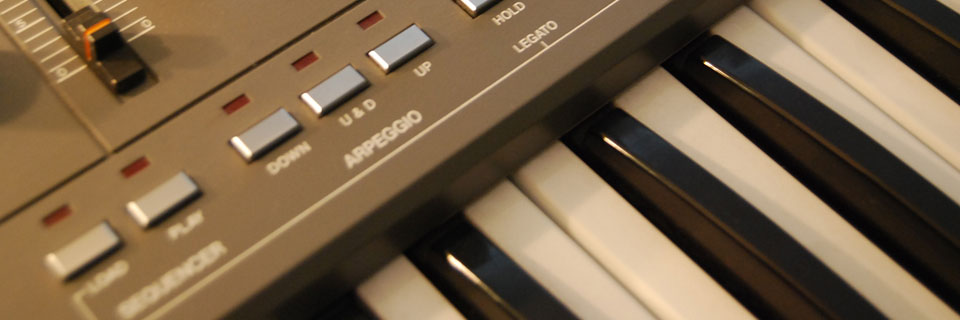Monophonic
A monophonic instrument is one that can only produce one note at a time, therefore it is impossible to play chords on them. A flute is monophonic. Throughout the 60’s and 70’s affordable electronic instruments were only capable of monophonic performance (eg the Moog Mini Moog). At the beginning of the 1980’s affordable mono synthesisers such as the Sequential Circuits Pro 1 (£1000) and Roland’s Sh201 (£199) were still being made. Even today new methods of synthesis often arrive in monophonic form first until being available in polyphonic form when processor speed and price improves. The Korg Prophecy is a good example. It uses of form of synthesis called physical modelling. This is very processor intensive.
There are some advantages in monophonic performance. Because subsequent notes turns off previous ones a clean playing style can be developed. They tend to make good instruments for bass and lead line performance.
Polyphony
Polyphonic means many notes at once, thus it is possible to play chords on such instruments. A piano is the most polyphonic of instruments. If you had enough hands you could play all 88 notes simultaneously.
The first affordable polyphonic synthesisers were the Sequential Circuits Prophet 5 (5 note polyphonic, about £5,000), the Moog Memory Moog (about £6,000), and in the early eighties the Roland Juno 6 and 60 (6 note polyphonic, about £600-800). Today, depending on the synthesis method involved, it is common to have between 8 and 128 note polyphony.
Note stealing
When using an instrument with limited polyphony note stealing can become a problem. If a chord is played and sustained that uses all the available notes the addition of a subsequent additional note will cause one of the existing sounding notes to be cut-off or stolen.
Voices
It is useful to think of a polyphonic instrument as having a number of separate sound generating components or "voices". Thus a 6 note polyphonic instrument has 6 voices and a 128 note instrument has 128 voices. A monophonic instrument has 1 voice.
When layering 2 sounds together on a synth, each single note played will require 2 voices to sound. Also when a sound is programmed that uses several basic sound components (eg PCM samples) polyphony may be reduced.
Multitimbral problems
Today it is common to use a single synthesiser, sound card, or sampler to play all the parts/sounds of a composition in multi-timbral mode. It is therefore important that the instrument has as much polyphony as possible.
If you were using a 32 note polyphonic multi-timbral instrument to play 8 separate performance it may be that the instrument assigns 4 of its voices to each sound. But if one of the sounds only requires one voice (perhaps a monophonic bass line part) then the 3 other voices assigned to this sound will be wasted. Also a sound that requires 5 voices to play its part will not be able to, notes will be missing.
Dynamic allocation
This is a method by which sounds in a multi-timbral instruments only use the voices they need, leaving the others available to any other sound that needs them.
Priority settings
The Akai range of hardware samples allows the user to set priority settings when the instrument is in multi-timbral mode. Thus the user can ensure that one set of sounds (eg the drum kit) will never have notes stolen from it.

